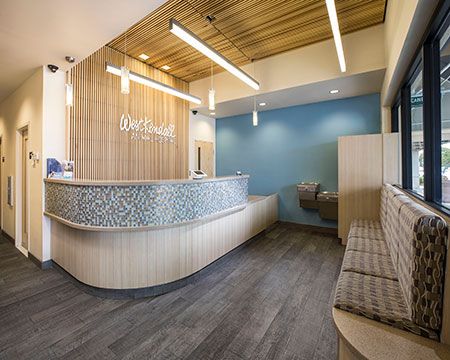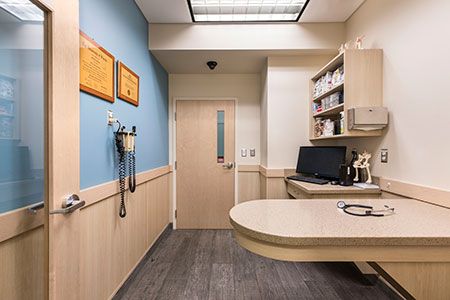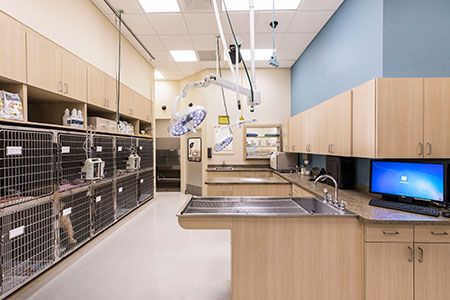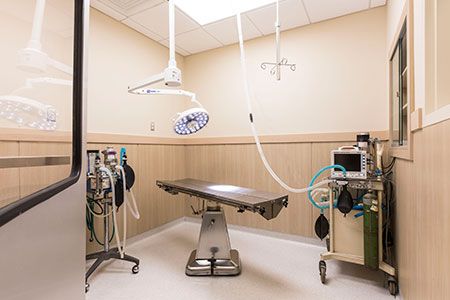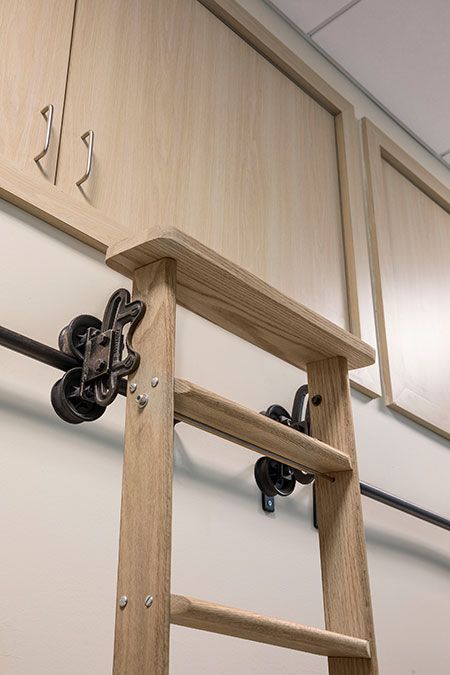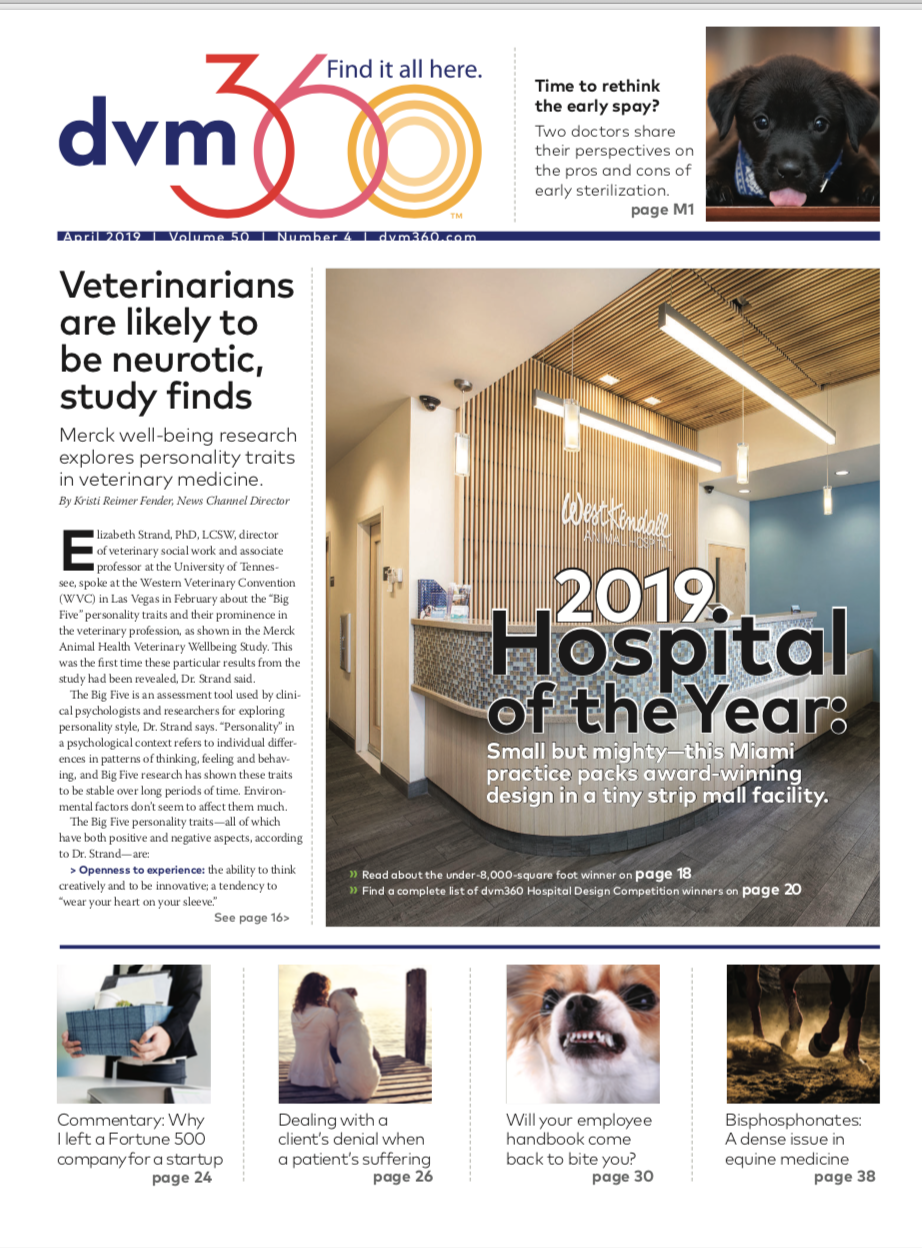After 30 years in a strip mall storefront, clients are now enjoying a fresh look to West Kendall Animal Hospital. Dr. Davidson had the front door moved from the center of the storefront to the left, allowing space for bench seating along the front windows with direct access to the reception desk. Blue paw print decals on the windows tie in with the blue accents throughout the hospital.
Coming in at only 2,100 square feet, you wouldn't think the remodel of West Kendall Animal Hospital in Miami, Florida, would be that challenging or take too long. But practice owner Jeffrey Davidson, DVM, says the process took a whopping five years from start to finish. If you ask Dr. Davidson if it was worth it, he'll give a resounding yes. Many great things came from the long, drawn-out process, leading to the practice winning the dvm360 Hospital Design Competition Hospital of the Year Award for practices under 8,000 square feet.
The reception desk and the wood and tile design elements are a splurge that Dr. Davidson says was worth every penny. "My reception area is the place to show off to clients, our first impression area," he says. "It all comes with a price, and this is a splurge I was willing to pay. There weren't too many of them." The elevated ceiling with a wood slat design continues down behind the reception desk a few inches away from the wall. Pendant lighting and blue tiles around the desk tie it all together.
By the numbers-West Kendall Animal Hospital:
- Owner(s): Dr. Jeffrey L. Davidson
- Number of doctors: 1
- Exam rooms: 3
- Total cost: $498,536
- Cost per square foot: $201.38
- Square footage: 2,100
- Structure type: Leasehold, renovation
- Architect: Rauhaus Freedenfeld & Associates
- Photographer: Craig Denis Creative
Hospital Design Competition judges praised West Kendall Animal Hospital for great color combinations and finishes, high design standards, and a “solid” floor plan, especially in such a narrow space. One judge said it's not easy to hold a design to such high standards when the facility is so small, but Dr. Davidson and his architecture team at Rauhaus Freedenfeld and Associates managed to do just that.
Working and waiting
One benefit of the long timeline was time to think. And to dream. And to plan. Dr. Davidson had plenty of time and put it to good use.
Want more dvm360 Hospital Design Competition content?
Click here for a list of winners of this year's competition and a schedule of when to keep an eye out for them to be featured in print and on dvm360.com.
Click here for the 2019 People's Choice Award competition and images of all 17 of this year's entrants.
Keep your eyes open for the 2019 Hospital Design Supplement arriving in May with your issue of dvm360 magazine for even more great design content.
His story started in 1986, when he built his practice in a strip mall. The 1981 graduate of the University of Florida Veterinary School started in that leased space between two anchor tenants. He was the first business in the strip, besides the anchors. That location served him well for many years, but it didn't stop him from keeping an eye on design trends and dreaming of a fresh space.
Exam room needs drove much of the hospital renovation. Dr. Davidson gave up boarding space in the back of the hospital to make room for an extra exam room--going from two to three exam rooms, enlarging the rooms a bit as well. And another must-have: Two doors in and out of exam rooms. "In our old facility, our exam rooms were so close to the reception area that I would always get stopped coming out of a room, and it really messed with my productivity," he says.
“I decided about five years before the remodel that I needed something more than just a facelift,” says Dr. Davidson. He had done a few minor updates through the years, but this time required more.
As luck would have it, his next-door tenant didn't need all the space his leasehold had and didn't want to spend so much on the rent. Dr. Davidson asked his neighbor if he could have the extra space instead, and the tenant agreed. But it took five years for the landlord to get on board and present him with a new lease proposal.
The new treatment area features ICU cages along the left side, easily visible for observing critical pets while caring for others. The renovation allowed for the addition of a dedicated wet table for dentals and flushings, and another table as well. The room also has a pass-through window to surgery, a computer workstation between the two treatment tables, and a computer just for viewing radiograph images.
“I didn't want to do a major remodel, then have to do it again once I got the additional space,” he says. “More space would take me from an I-shaped building to an L-shaped space, opening up more options for my floor plan.”
During that delay, Dr. Davidson pored over plans, took notes of what he would want in each area of the practice, found a veterinary-specific architect and got the ball rolling on designs.
The permitting process also moved slowly. Dr. Davidson used the opportunity to fine-tune the designs his architect, Warren Freedenfeld, created: “I spent a lot of time with the plans, making changes as I would walk through each room every day, figuring out where I wanted every single little thing. Not being so rushed helped me end up with a better plan. I had time to change things, down to the details of where I wanted outlets and cables to go.”
While the delays were frustrating, Dr. Davidson credits them with giving him time to make the hospital the best it could be.
Working through a remodel
“Working while you're constructing is the best solution, for me, if you want to stay in business,” Dr. Davidson says. But it's not without its challenges. He considered moving into a temporary space in the shopping center during construction, but no spaces were available when he needed it. Moving to another location could have worked, but Dr. Davidson didn't want to disrupt continuity for his clients. He even considered renting a trailer in the parking lot for space. The landlord signed off on that, but in the end, he went for a two-phase construction.
Attack your project from every angle at the HospitalDesign360 conference
Attend the 2019 HospitalDesign360 conference (formerly the Veterinary Economics Hospital Design Conference) in Kansas City, Missouri, Aug. 21-23.
Gather ideas, learn from the profession's most noted veterinary design experts, and compare your options for design, construction, equipment, financing and more with our exclusive hospital design exhibit hall. Visit fetchdvm360.com/hd for more information.
Bonus! Practice owners from both of this year's Hospitals of the Year will be on hand to share their secrets.
While they tore down walls-some all the way down to the studs in his existing space and in the tenant space-Dr. Davidson and his team worked solely out of the front of the practice, using reception, exam rooms, lab, treatment and surgery, while construction went on in the back of the practice and in the new tenant space. The builders converted the old kennel area and all of the newly acquired space during phase one. That gave him a new surgery suite, radiography room, treatment room and an extra bathroom.
The surgery suite was designed with positive ventilation, a pass-through window for access on either side and a viewing window. "I wanted to be in surgery and look out and see where staff members are if I need them or to view the animals in cages just outside surgery," says Dr. Davidson. He chose wainscoting for the walls with laminate that he says is impervious to dings from moving equipment or stains. Medical grade vinyl flooring is easy on the feet as well as easy to clean, coved up the wall without seams.
Phase two meant moving to the back of the hospital, walking clients down the unfinished area into a sparkling new space for a few months. “We brought clients into the treatment room, using that area as our exam room,” he says. “It was hugely inconvenient, as we could only see one patient at a time, but we managed. Thankfully that phase didn't last long, and our clients were happy to get a peek at the new construction. They were very considerate and never complained about the wait or the mess during construction.”
Dr. Davidson has mastered the art of finding storage in every possible spot. The seating bench in the reception area has hidden storage for holiday decor and other items not used often. Above the exam rooms is storage space that is only accessed from the corridor with a rolling ladder. Here they store light bulbs, tiles, air filters and other items often bought in bulk and not needed on a daily or even weekly basis.
Despite the long wait and the inconveniences, not to mention the cost, Dr. Davidson says it's hard to imagine how he practiced in that space for so long before. “The work flow is better, I'm happier having more elbow room, my staff has space to put their things, and the whole place looks nicer and is so much more enjoyable,” he says.
Sarah A. Moser is a freelance writer in Lenexa, Kan.

